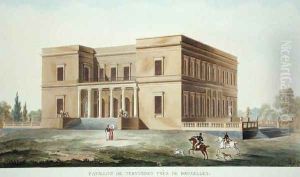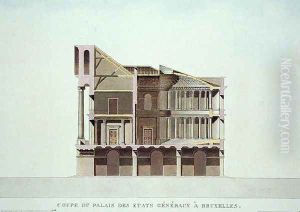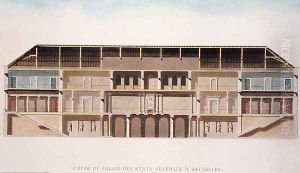Charles Vander Straeten Paintings
Charles Vander Straeten, born in Brussels, Belgium, on October 2, 1771, was a neoclassical architect and designer renowned for his work during the late 18th and early 19th centuries. Initially trained under the guidance of the architect Laurent-Benoît Dewez, Vander Straeten's career was significantly influenced by the neoclassical movement that was prevalent in Europe during his time, emphasizing the revival of classical Greek and Roman architecture and design.
Vander Straeten's work is characterized by its elegant simplicity and adherence to classical principles, which he applied to both public and private buildings throughout his career. He was an active figure during a transformative period in European history, which saw the waning influence of monarchical power and the rise of bourgeois values and aspirations. His designs, which often included elements such as grand staircases, spacious courtyards, and meticulous attention to proportion and symmetry, reflect the ambitions and tastes of his patrons, who were often members of the aristocracy or the emerging wealthy classes.
Notably, Vander Straeten worked extensively in the service of the Prince of Orange-Nassau, for whom he undertook several important commissions. One of his most significant works was the refurbishment and interior decoration of the Pavillon de Tervueren, also known as the Château de Tervuren, which was carried out between 1821 and 1825. The project was part of a larger plan to transform the area into a royal summer residence and involved extensive landscaping and architectural work.
After Belgium gained independence from the Netherlands in 1830, Vander Straeten continued to work and receive commissions from the new Belgian monarchy and aristocracy. His contributions to architecture and design during this period were instrumental in shaping the aesthetic landscape of the newly formed nation.
Charles Vander Straeten's career ended with his death on September 11, 1834, in Brussels. His legacy endures through the buildings and interiors he designed, which remain as testaments to the neoclassical style and the cultural aspirations of his era. His influence also continued through the works of his students and the subsequent generations of architects who were inspired by his dedication to classical ideals and architectural elegance.


